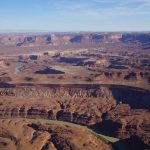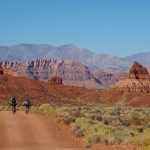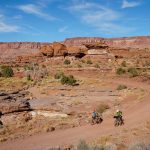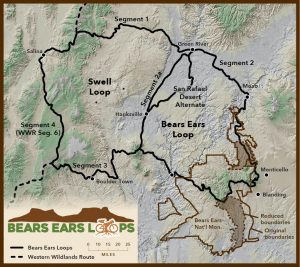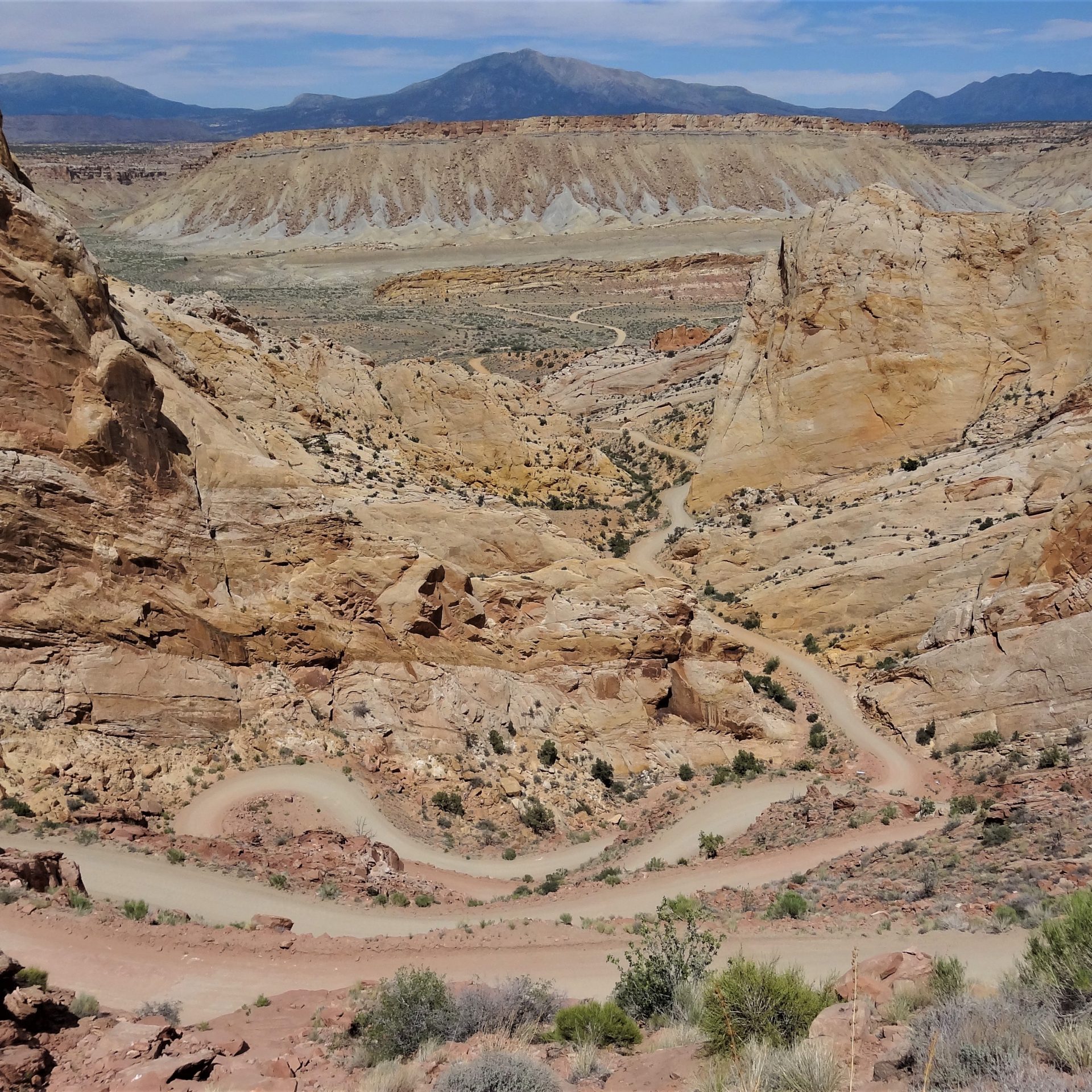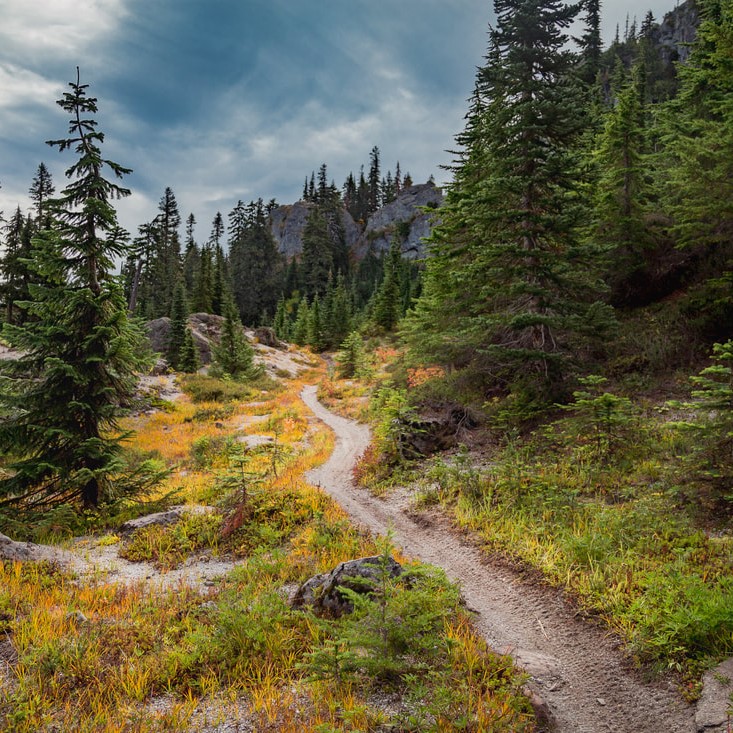Route Overview
Region
Miles
Days Out
Physical Difficulty
Season
Elevation Gain
Tire Size
Technical Difficulty
Route Map
Route Details
What are the Bears Ears? The Bears Ears are adjacent two buttes resembling a pair of bear ears that rise from high on a plateau in southeastern Utah. Visible from many vantages for a hundred miles or more in most directions, these buttes have stood throughout human time and have deep cultural, historic, and political significance. We created the 700-mile Bears Ears Loops network to immerse bikepackers in this immense, complex, magnificent, and threatened landscape.
The riding experience has been intentionally designed to not be particularly technical, to necessitate anything beyond traditional mountain bikes, or to only be accessible for particularly experienced bikepackers. We have chosen to avoid increasing visitation to some of the most exceptional and seldom-visited areas of the Bears Ears National Monument region to avoid additional impacts. We ask that you help protect and advocate for Bears Ears’ protection and conservation.
- Red rock canyons and cliffs along the Green and Colorado Rivers
- High, cool riding through the Abajo and Henry Mountains
- Views of the Colorado Plateau from Bull Creek Pass
- Otherworldly rock formations in the San Rafael Swell
- The Burr Trail Road through Capitol Reef National Park
- Lush, forested flanks of the Aquarius Plateau
- Skyline Drive, following the Wasatch Crest for 75 miles
- Pando Aspen Grove, the largest known organism in the world
- What kind of bike should I ride? We recommend a mountain bike with tires at least 2.2” wide, ample sealant, and low gearing. You may also appreciate front suspension. Cyclocross and gravel bikes and trailers are not recommended for this route.
- What’s the ideal time of year to ride the route? Generally late spring or early fall, but it depends on the year. See the route guide for more details.
- How long will the route take to ride? Generally 9 to 14 days, but it depends on the rider. Don’t underestimate the ruggedness of this route.
- Do I need any special permits? No.
- Are there any specific safety considerations on this route? (1) There is limited water on this route. Pack at least 8 liters of capacity, plan carefully, and carry more than you expect to need. (2) Long stretches of the route can become absolutely impassible when wet. Pay close attention to weather forecasts and carry extra food in case you need to wait for a road to dry out. See the route guide for more details.
- What is the longest distance between water sources? 82 miles. See the route guide for more details.
- What is the longest distance between resupplies? 108 miles. See the route guide for more details.
- Is it easy to find places to camp? Yes, dispersed camping is generally easy to find on the public lands the route passes through, but some sections pass through private lands where you would need permission to camp. See the route guide for more details.
- Can I ride the route in either direction? Yes.
- How do I follow the route? These routes are not marked on the ground in any way. You will need to load the route data onto a GPS unit, or use the FarOut Smartphone App.
- Why didn’t you include x road/area in these routes? There are infinite possibilities for creating routes. Our choices include a range of considerations that aim for the most enjoyable riding experience possible.
- Are you going to organize races on any of these routes? We are not, and we ask that riders do not do any sort of racing on these routes. This route crosses private land and the Navajo Nation, and those permissions could be jeopardized by riders pushing limits and getting into trouble or by disregarding special regulations for these sections of the route, which are far more likely in race scenarios.
If you encounter any inaccuracies or changes please let us know at [email protected]
Updates affecting Bears Ears Loops (last updated 16 May 2023):
- Segment 2 – Hite, UT: The Hite Outpost store, RV park, and ranger station are both CLOSED for 2023
- Segment 2 – Grand County Human Waste rule: A new rule for ALL public lands in Grand County, Utah, requires that ALL human waste be packed out rather than buried. This includes the section of Segment 2 between Green River and ~8 miles south of Moab.
- Segment 2 – Moab area camping: New dispersed camping rules went into effect for 2023, and if camping along Cotter Mine Road just north of town, campers are required to pack out ALL human waste. No other changes affect this route; see this great BLM map for camping opportunities/restrictions in the Moab area.
- Segment 2: Lockhart Basin Road between Moab and Canyonlands National Park to the south: This stretch of the route is especially rough, loose, and sandy condition after flash flooding during the summers of 2021 and 2022. Riders should generally not plan on completing the section between Moab and the Canyonlands Outpost Store/Indian Creek in a single day.
- Segment 3a: Along the San Rafael Desert Alternate, Jeffrey Well is dry. But an alternative water source can be found at Saucer Basin Well.
- Segment 3: McMillan Campground on the western side of the Henry Mountains has a brand new water pump! This has become a reliable water source, although it will likely be turned off later in the season. Contact the BLM Office in Hanksville for when that may occur.
- Segment 3: The irrigation ditch at Sandy Ranch at the base of the west side of the Henry Mountains is not currently carrying water. The ranch is under new ownership.
- Kurt Refsnider and Kait Boyle for their route development.
- This route traverses the traditional lands of the Ute, Southern Paiute and Pueblo peoples.
Segments
- The Western Wildlands Route to Green River
- 110 miles
- 3,300’ elevation gain
- 80% natural surfaces, 20% paved
- 2-3 days out
- 6/10 physical difficulty
- 4.5/10 technical difficulty
From above 10,000 feet in elevation on the high Wasatch Plateau to the Green River 6,000 feet below, Segment 1 emphasizes the topographic relief of the Colorado Plateau. In between those endpoints lies the ranching town of Castle Dale and the remote and shadeless periphery of the San Rafael Swell. The Swell is an upwarped region of bedrock that has been eroded into rugged castles, hogbacks, fins, and canyons that are visible from the route. Nearer to Green River, barren shale badlands become more dominant. The riding on this segment is mostly on bladed gravel and dirt roads with 20 miles of rougher 4×4 track on the east side of the San Rafael Swell toward Green River. Virtually all of this segment is impassable when wet.
- Green River to the Henry Mountains
- 291 miles
- 23,000’ elevation gain
- 65% natural surfaces, 35% paved
- 5-7 days out
- 6/10 physical difficulty
- 4.5/10 technical difficulty
This segment is canonical Colorado Plateau riding at its finest – wide open high desert badlands, deep sandstone canyons, isolated mountain ranges, cliff bands that stretch as far as the eye can see, and so much more. After the quiet shale hill country between Green River and the bustling tourist hub of Moab, this segment crosses the original boundaries of Bears Ears National Monument and snakes its way above the Colorado River on the Lockhart Basin 4×4 road adjacent to Canyonlands National Park. Then the route climbs into aspen and spruce forests high in the Abajo Mountains before traversing southward to the scenic Elk Ridge. Still high above the desert, Elk Ridge offers refuge from the warmer temperatures below. At the southern end of Elk Ridge stand the revered Bears Ears Buttes, sentinels over the distant canyon country. Turning west, the route gradually descends amid redrock mesas and deep canyons toward the Colorado River bridge and the northernmost extent of Lake Powell at Hite. High above the towering sandstone cliffs are the Henry Mountains, the last mountains in the Lower 48 to be surveyed. A quiet paved climb amid slickrock walls leads to those mountains, and a rougher 4×4 track climbs to Wickieup Pass at just over 10,000 feet elevation at the crest of the range. Long stretches of this segment are impassible when wet, necessitating paying close attention to weather forecasts.
- Green River to the Henry Mountains
- 81 miles
- 1,500’ elevation gain
- 45% natural surfaces, 55% paved (95% natural surfaces on the San Rafael alternate)
- 1-2 days out
- 5/10 physical difficulty
- 3/10 technical difficulty
This short segment connects the crest of the Henry Mountains north to Green River through the San Rafael Desert. After expansive views at Wikieup Pass, the route descends steadily from 9,000’ to nearly 4,000’ at the small ranching town of Hanksville on maintained dirt roads. North of Hanksville, riders can opt to stick to the quiet Highway 24 pavement along the eastern edge of the San Rafael Swell and among sand dunes and badlands to pass the warm low-elevation miles more quickly. However, the San Rafael Desert Alternate offers an off-pavement option to the east on bladed dirt roads that may be sandy and washboarded in places. The southern half of this segment and much of the San Rafael Desert Alternate are impassible when wet, necessitating paying close attention to weather forecasts.
- Henry Mountains to the Western Wildlands Route
- 117 miles
- 12,000’ elevation gain
- 80% natural surfaces, 55% paved
- 2-3 days out
- 6/10 physical difficulty
- 4.5/10 technical difficulty
From the isolated peaks of the Henry Mountains to the sprawling Aquarius Plateau, this segment begins and ends at 10,000 feet. Near the eastern end of this segment at Bull Creek Pass, a short trail to the summit of Mount Ellen is well worth the side trip. Below the high peaks and plateaus lies the Burr Desert and Capitol Reef National Park where tilted layers of sandstone in the Waterpocket Fold create a nearly impenetrable barrier to travel. The Burr Trail switchbacks negotiate those sandstone hogbacks and provide access to the quirky rural community of Boulder Town. After the dry slopes of the Henry Mountains, the forested flanks of the Aquarius Plateau will feel downright lush, complete with flowing streams and small lakes. Long stretches of this segment are impassible when wet, necessitating paying close attention to weather forecasts.
- Western Wildlands Route to Salina
- 128 miles
- 9,000’ elevation gain
- 75% natural surfaces, 15% paved
- 2-4 days out
- 6/10 physical difficulty
- 4.5/10 technical difficulty
Running congruently with part of Segment 6 of the Western Wildlands Route, Segment 4 traverses the western margin of the Colorado Plateau through Utah’s high plateau country. The climbs and descent are long, the views from up high are absolutely massive, and the geology dramatic. Elevations range from 5,000 feet in the lowest basins to well over 10,000 feet atop the highest plateaus. The northern end of the segment is on the Wasatch Plateau, following part of Skyline Drive, a 100-mile-long rugged and rough 4×4 road that traverses the length of the plateau. Heading southbound, the route plunges 5,500 feet down to the town of Salina before climbing more gradually along creeks and through higher sage-covered valleys to the scenic Fish Lake to the north. A descent leads to the small town of Loa before another 3,000 foot ascent takes riders back into the pines atop the sprawling Aquarius Plateau. Long stretches of this segment are impassible when wet, necessitating paying close attention to weather forecasts. Snow will likely persist into early summer on this segment, longer than any other parts of the Bears Ears Loops.



